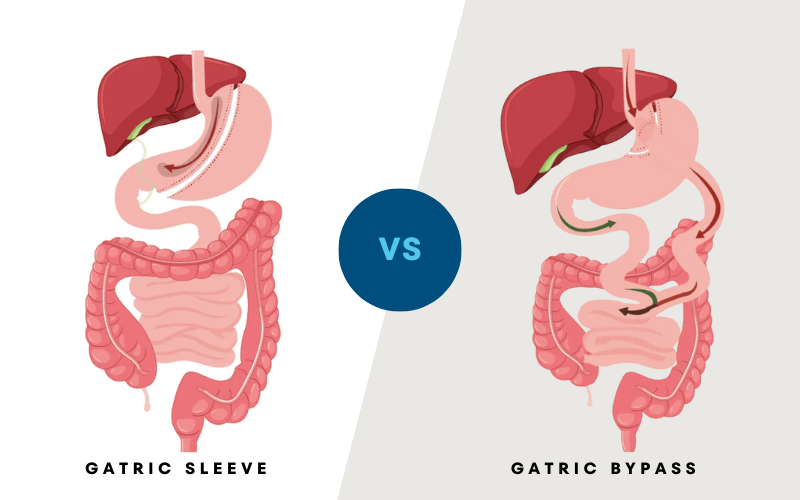Which Weight Loss Surgery is Right for You?
There is an endless amount of information surrounding weight loss, dieting, and well-being constantly flying around us on the internet. Every time we check Instagram, there is a new influencer spouting the benefits of a different laxative tea. There are also a plethora of reasons as to why you might be struggling to lose weight. In such a world, it is important that you come to the right place for your information, and consult with experts that have extensive experience, and understand how your body really works.
You can rely on the team at Perth Weight Loss and Surgery, to provide you with all the facts, advice, and support that you may need in your weight loss journey and bariatric surgery experience.
When we understand something, there is no need to be anxious about it. We know the importance of our patients being well-informed. We recognise that the different weight-loss surgeries can sometimes bring about some misconceptions or sound confusing, the names may all sound similar to one another, or overly filled with medical jargon. Therefore, read on to find some clarity about the differences between each surgery.
Information Common to All Bariatric Surgeries
- 99% of weight loss surgeries are laparoscopic or ‘keyhole surgeries’.
- All bariatric surgeries will aid in varying degrees of weight loss, and therefore reduce the risk of health complications due to diabetes and heart conditions.
- Most of the surgeries will require you to stay in the hospital for no longer than 1-2 nights.
- All of the surgeries decrease appetite and portion size and therefore promote weight loss
- If your BMI is higher than 35 – you are eligible to talk to our surgeons about the bariatric surgeries. Feel free to use our BMI Calculator on our website: https://perthweightlosssurgery.com.au/
1. Bariatric Surgeries – Stomach:
Lap Band Surgery
A Lap Band Surgery entails the creation of a small pouch at the top of the stomach, with the placement of a silicon-based band, the size of which can be adjusted throughout the patient’s weightloss journey.
Advantages:
- Reversible – the lap band can be removed if needed due to changing health conditions.
- No part of the stomach or intestine is removed or sectioned
Disadvantages:
- More than 40% chance of the need for a Revisional/Conversion bariatric procedure (see more information on this below).
- The quality eating is reduced – the diet after the surgery is very strict
- The chance of the mechanism (the lap band and the port) moving or eroding once installed
Gastric Bypass Surgery
A Gastric Bypass surgery entails a small part of the stomach being surgically sectioned off, to create a small pouch at the top of the stomach and reconnecting small bowel to this pouch. Effectively reducing the size of the stomach, and therefore decreasing the appetite.
Advantages:
- Very predictable weight loss outcomes – there is a lot of supporting evidence from the medical community with long term data.
- The strong positive effect on Type 2 diabetes, obstructive sleep apnoea, and other weight-related problems
- Low revisional conversion procedures are usually needed.
Disadvantages:
- There is a higher risk of nutritional deficiency, compared to other surgeries
- Although complications are rare, they can be slightly more serious than other surgeries – including the risk of an ulcer in the joining tissue between the stomach and the intestine, internal hernia and dumping syndrome.
Gastric Sleeve Surgery
A Gastric Sleeve Surgery entails the surgical sectioning of a vertical, tube-like pouch from the stomach. This effectively removes the use of 80-90% of the stomach. The remaining sleeve of the stomach is still connected normally to the intestine, however, the stomach now holds only one tenth of what it could before the surgery.
Advantages:
- The higher quality of eating is maintained – in comparison to the gastric band surgery – the patient can eat a wide range of foods, just in smaller amounts
- The intestinal tract continuity is maintained
- Less chance of an ulcer than gastric bypass surgery
- Lower risk of complications in terms of blockages in the intestine or nutrition deficiency
Disadvantages:
- Irreversible – once the stomach is removed, the surgery cannot be undone
- Complications are rare – but can arise due to the stapling of the stomach causing the potential for leaks
- Weight-loss outcomes can be lower – as the body can still tolerate high-fat foods and patients aren’t forced to have as strict of a diet.
Key Difference between Lap Band Surgery, Gastric Bypass and Gastric Sleeve:
The main difference that defines each of the aforementioned weight loss surgeries, is the method by which the stomach size is reduced. The resulting level of weight loss also differs between each procedure.
Your surgeon will advise you upon which surgery is most suited to your body type, your medical history and the goals for your weight loss journey.
2. Bariatric Surgeries – Stomach and Intestines:
SADI-S / SIP Surgery
The acronym SADI-S stands for Single Anastomosis Duodeno-Ileal Bypass with Sleeve Gastrectomy. This procedure is also known as SIPS, an acronym that stands for Stomach Intestinal Pylorus-Sparing Surgery. Some surgeons refer to this procedure as a “super-charged gastric sleeve surgery”.
The first step of a SADI-S/SIPS procedure includes the sleeve gastrectomy. The sleeve gastrectomy is essentially the same process of creating a Gastric Sleeve, as aforementioned.
Please see the Summary of Gastric Sleeve Surgery above.
However, this procedure differs from a simple Gastric Sleeve surgery, in the second step.
Essentially, the second step shortens the small intestine. There are three sections to the small intestine. In this surgery, the intestine is surgically detached from the end of the first section of the small intestine and then reattached to the start of the third section of the small intestine. Therefore, the middle section of the small intestine is bypassed.
Advantages:
- Is more effective at boosting the metabolic rate than other bariatric surgery
- Can be performed on people that already have a gastric sleeve
- Provides greater weight loss outcomes than gastric bypass or gastric sleeve surgeries
Disadvantages:
- This procedure is relatively new, compared to other bariatric surgeries. Therefore, there is less documentation of risks and outcomes in the medical community.
- Higher risk of nutrients deficiency
- Higher level of the long term follows up and close monitoring with the doctor after their surgery
SASI-S Procedure
The acronym SASI-S stands for Single Anastomosis Stomach-Ileal Bypass with Sleeve Gastrectomy. The SASI surgery differs only slightly from the SADI-S as mentioned above.
The first step is the same as in the SADI-S procedure, of creating the gastric sleeve. However, in the second step, the gastric sleeve is connected directly to the third section of the small intestine. This means that a larger portion of the small intestine is bypassed than in SADI-S. Therefore, less calories are absorbed, as the food spends an even shorter time moving through in the intestinal tract.
Advantages:
- May provide greater weight loss outcomes that gastric sleeve and bypass surgeries.
- Low risk of nutritional deficiency compared to SADI-S
- High quality of eating available to the patient after surgery
- Low risk of internal hernia
Disadvantages:
- Increased risk of bile reflux to the stomach, which can be uncomfortable for the patient
- Similar to the SADI-S, this procedure is relatively new, compared to other bariatric surgeries. Therefore, there is less documentation of risks and outcomes in the medical community.
- The risk of an ulcer forming where the stomach and the intestine become surgically attached.
Revisional Conversion Bariatric Surgery
A revisional conversion bariatric surgery can take a variety of forms. Essentially, it is the name given to procedures that alter a previously performed bariatric surgery, including all of the aforementioned surgeries. For example, if a patient already had undergone Lap Band surgery, and then decided with their doctors that further help was needed in the weight loss journey, a revisional conversion bariatric procedure could be performed to remove the lap band and create a gastric sleeve or from a gastric sleeve to a gastric bypass.
Advantages:
- This surgery can be used to treat complications or restore the anatomy of the stomach, depending on differing health conditions.
- The recovery time for this is often very quick, with the patient only usually having two nights in hospital after the surgery.
- Helps to avoid the regaining of weight, and keep the patient’s weight loss journey on track.
Disadvantages:
- As with all bariatric surgeries, there can be complications. The disadvantages of the revisional conversion bariatric surgery will depend on the type of surgery that the patient has had previously.
Key Difference between SADI-S/ SIPS, SASI-S and Revisional Conversion Bariatric Surgery:
In terms of the comparison between SADI-S and SASI-S, the main difference is wherein the small intestine is attached.
Where SADI-S and SASI-S would complete the sectioning of the stomach and adjustment of the intestines in one surgery, the revisional conversion bariatric surgery will be performed after the first step of creating a gastric sleeve, for example, has already been performed in a separate previous surgery and revision is done for reasons like weight gain and reflux.
Your surgeon at PWLS will advise you upon which surgery is most suited to your body type, your medical history, and the goals for your weight loss journey.
For more information about each surgery, please see the Weight Loss tab on our website.
Feel free to contact Perth Weight Loss and Surgery with any questions or concerns, just give us a call on 08 6155 8822.






